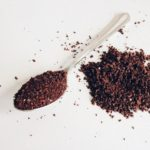If you’re worried about drinking too much coffee, and the amount of caffeine flooding your system, you might decide to swap to tea; and green tea is increasingly popular. While you might at first think about black tea as an option (you know, English or Irish breakfast, Assam, Earl Grey), everyone knows that the amount of caffeine in these varieties is still pretty high. So what about green tea? Surely the amount of caffeine in green tea is negligible? I mean, does green tea even have any caffeine?
Caffeine in coffee
So how much caffeine is there in a cup of coffee? Like tea, the caffeine content in your coffee is affected by many factors – it varies depending on the beans used, how the brew is prepared, how large a serving you’re enjoying, and how heavily you dilute the coffee with water.
Typical caffeine content of a cup of coffee
For a typical cup of coffee, around 8 fluid ounces, you’re looking at somewhere between 70 and 140mg of caffeine, with the average around 95mg. For instant coffee, you can safely assume the content is around 63mg, while for brewed filter coffee, typical amounts are around 95 to 165mg. Even lattes and mochas have around 63mg at the lower end, or as much as 126mg. Decaffeinated coffee has around 2mg of caffeine per cup.
Caffeine in tea
As well as the length of time that the tea is brewed (or “steeped” as my English mom would say), many factors can change the levels of caffeine in tea. Believe it or not, the age of the leaves makes a difference: buds and new leaves generally have higher caffeine levels. When the tea is harvested also changes things. Tea that is picked early in spring has a higher caffeine content than tea picked later on.
Does green tea have caffeine?
The green tea does contain caffeine, although it’s both black tea and coffee have considerably higher caffeine levels. It’s an error that many of us have made at one time or another, including me; thinking that green tea has no caffeine. That isn’t the case; unless it’s one of the decaffeinated varieties that you’re enjoying, you’ll find around a quarter of the amount of caffeine in green tea that you’ll find in the same sized cup of brewed coffee.
Typical caffeine in a cup of tea
An average cup of black tea has around half the caffeine that you’ll find in a typical serving of brewed coffee, while a typical cup of green tea has around a quarter.
Even if you swap to decaffeinated tea, you’re still going to be taking in between 2 to 4 mg per cup. While green tea is generally healthier for you it’s not completely caffeine-free, with between 35 and 80mg of caffeine depending on the variety and the brewing method.
Caffeine in coffee versus caffeine in tea
Well, in general tea has a lot less caffeine than coffee, right? Well, yes and no. While the average cup of tea is lower in caffeine than the average cup of coffee, that isn’t always the case. Some tea blends are actually higher in caffeine than coffee – and it all depends on a series of factors. While your typical cup of coffee has somewhere between 100 and 400mg of caffeine, an equivalent 8 oz cup of tea has somewhere between 30 and 55mg of caffeine.
What’s caffeine again, anyway?
So we all know it’s the substance in our tea or coffee (or some sodas) that gives us an energy boost and can be pretty addictive, but what is caffeine, when you come down to it? Well, caffeine, or, if you’d like to use its full, scientific name, 1, 3, 7- trimethylxanthine, is actually a toxin that naturally occurs in some plants. The plants use it to defend themselves; and while it is a toxin, it’s one that doesn’t harm humans, in small amounts anyway, and actually has many beneficial effects for most of us.
You mean where the tea is grown matters too?
The location of the tea plantation makes a huge difference too – altitude, climate, rainfall and other environmental factors all play their part. And while traditionally we might think of India or China as locations where tea is generally grown, you might be surprised to learn that many parts of the United States now grow tea very successfully.

Bring us a brew…
Quite apart from all of that, the caffeine in your “cup of char” will be affected by how many parts water to how many parts tea you’re using and how long you let your tea brew, and the temperature of the water you use to make it. Using boiling water releases more caffeine than if you simmer the tea at a lower temperature.
Even the brand makes a difference; recent tests showed that Exotica Dragonwell tea has over 6 times as much caffeine as decaffeinated Stash Tea. All of the drinks tested were brewed for three minutes.
Variety is the Spice of Tea – Different Types of Tea
When we say “tea”, many of us mean what most of the world describes as “black tea”. Sure, it may say English Breakfast or Assam tea on the packaging but essentially, it’s black tea, and it comes from the dried leaves of the camellia sinensis plant. Actually, all teas come from this plant, what makes the difference to the color and the amount of caffeine initially is due to the ways in which the leaves are processed; but most tea does have caffeine.
How tea is processed
Black tea is oxidized fully; that is, before being crushed or rubbed (a process which is known as “rolling”), the leaves are left to wither completely in rooms where the humidity and temperature are carefully controlled. Once this process is complete, the leaves are dried. The levels of caffeine in black tea vary.
Green tea is not oxidized; instead, it is usually steamed or fired in a pan very soon after it has been picked. And for oolong tea, the caffeine content is somewhere between that of black and green tea, since this variety is only partially oxidized.
How much caffeine is there in loose leaf tea, teabags or ready to drink preparations?
Just how popular is tea?
After water, it’s one of the most widely consumed beverages in the world. In 2018 alone, 84 billion cups of tea were served somewhere in America; around 84% of those cups were black tea, with about 15% being green tea, and the remainder made up from oolong, white and other teas.

How much caffeine are we talking about?
Well, until New York tea merchant Thomas Sullivan invented the teabag in the early 20th century, all tea was a loose leaf. Surprisingly, mainly due to the fact that teabags mainly contain small leaves which have been broken into small pieces, the average teabag produces a cup of tea with higher caffeine levels than the same amount of loose tea.
Surely decaf coffee is devoid of caffeine?
Well, actually, no. It’s very low in the substance, compared to tea, coffee and other drinks, but there’s still a trace of caffeine – just how much caffeine you’ll find in decaf coffee depends on the brand but is usually between 2 and 4 mg per 8 oz serving. (source).
Should I go herbal?
Technically, herbal teas aren’t actually teas; they’re infusions. They’re one of your best completely caffeine-free options. Beware though – some herbal teas are prepared in the same factories as black, white and oolong teas, so a tiny bit of cross-contamination may occasionally occur. If you want to kick the caffeine habit temporarily, for whatever reason, but still need a boost, try teas with ginseng, ginger, peppermint or spearmint.
Whatever you decide to get you going in the morning, bottoms up, and enjoy.

Hi my name is Larry, a coffee aficionado from the US. I have already visited Colombia, Sumatra, Guatemala, Costa Rica, Ethiopia and Jamaica in my pursuit of finding the best-tasting coffee beans. I currently write from Bali and enjoy the relaxed life that you can only find in Canggu. Welcome to my coffee world!





